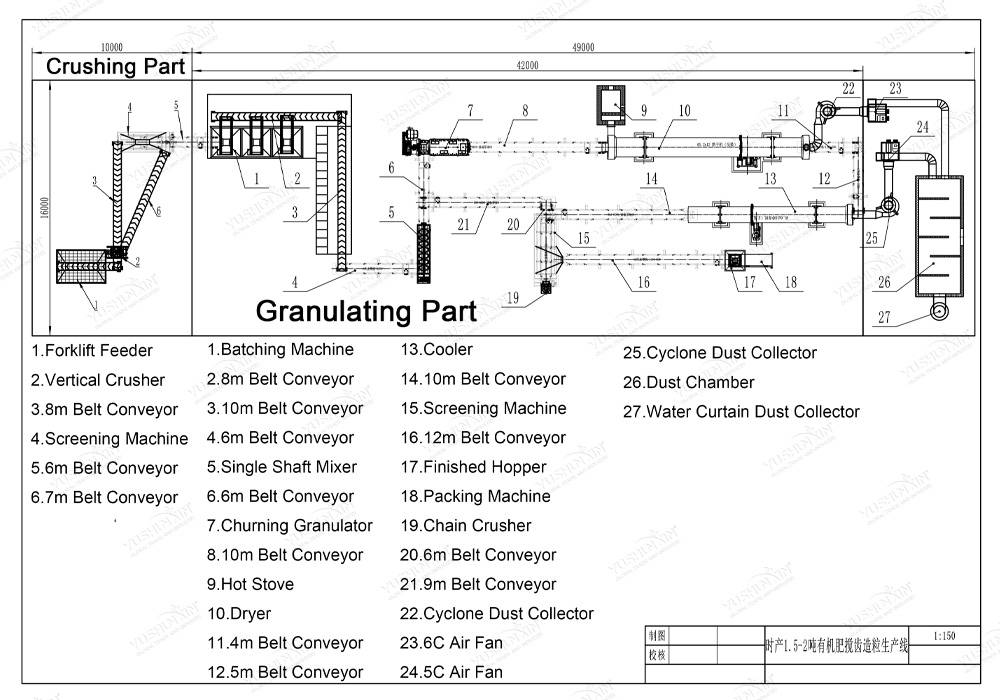







เพื่อเปลี่ยนหินฟอสเฟตให้เป็นปุ๋ยที่ใช้งานได้, จำเป็นต้องมีกรด “เป็นฟอง” ร็อค, ซึ่งปล่อยสารประกอบฟอสฟอรัสที่ละลายน้ำได้. กรดทั่วไปที่ใช้ได้แก่:
เพื่อสร้าง ปุ๋ยเอ็นพีเค, ไนโตรเจนและโพแทสเซียมจากแหล่งอื่นสามารถผสมกับวัสดุฟอสเฟตได้. ตัวอย่างบางส่วนได้แก่:
ต้นทุนของแต่ละสายการผลิตแตกต่างกันไปขึ้นอยู่กับกำลังการผลิต, ระดับของระบบอัตโนมัติ, และความต้องการเฉพาะ. กรอกแบบฟอร์มด้านล่างและเราจะให้ใบเสนอราคาที่ถูกต้องแก่คุณ!
หากคุณสนใจอุปกรณ์ทำปุ๋ยของเรา, โปรดส่งความต้องการและผู้ติดต่อของคุณแล้วเราจะติดต่อคุณภายในสองวัน. เราสัญญาว่าข้อมูลทั้งหมดของคุณจะไม่รั่วไหลให้ใคร.
- บริษัท ก่อตั้งขึ้นใน 2005 และมุ่งเน้นไปที่การวิจัยและพัฒนาและการผลิตอุปกรณ์ปุ๋ยอินทรีย์สำหรับ 20 ปี. มันได้สร้างฐานการผลิตอุปกรณ์ปุ๋ยขนาดใหญ่ 40,000 เมตรฐานการผลิต, ใช้แกรนูลขั้นสูง, เทคโนโลยีการอบแห้งและการคัดกรองเพื่อปรับปรุงประสิทธิภาพการผลิตและคุณภาพของผลิตภัณฑ์.
- องค์กรนำเข้าและส่งออกที่ดำเนินการด้วยตนเองด้วยมากกว่า 80 วิศวกรมืออาชีพทั่วโลก, ให้บริการมากกว่า 100 ประเทศและภูมิภาคต่างๆทั่วโลก, 5,000+ กรณีการบริการลูกค้า, 10 ศูนย์ประมวลผล, 3 เครื่องตัดเลเซอร์, และมากกว่า 60 อุปกรณ์ประเภทต่างๆ.
- รักษาความร่วมมือระยะยาวและกว้างขวางกับสถาบันวิจัยทางวิทยาศาสตร์และมหาวิทยาลัยหลายแห่ง, with a professional R&D team, สามารถเพิ่มประสิทธิภาพของอุปกรณ์อย่างต่อเนื่องตามความต้องการของตลาด.
- วัสดุทนต่อการสึกหรอสูง, เลือกคาร์บอนเหล็ก Q235/โลหะผสมเพื่อให้แน่ใจว่าอุปกรณ์มีความทนทานและลดค่าใช้จ่ายในการบำรุงรักษา.
- การใช้ระบบควบคุมอัจฉริยะเพื่อปรับปรุงระดับการผลิตอัตโนมัติและลดการพึ่งพาด้วยตนเอง.
- ISO, CE, การรับรอง SGS International
- ด้วยกำลังการผลิตขนาดใหญ่, สามารถตอบสนองความต้องการด้านกำลังการผลิตที่แตกต่างกัน (เล็ก, สายการผลิตขนาดกลางและขนาดใหญ่).
- รุ่นอุปกรณ์เต็มรูปแบบ, เหมาะสำหรับการผลิตปุ๋ยชนิดต่าง ๆ เช่นปุ๋ยอินทรีย์, ปุ๋ยผสม, ปุ๋ยชีวภาพ, ปุ๋ยที่ละลายน้ำได้, ปุ๋ยเหลว, ฯลฯ.
- การออกแบบส่วนบุคคลสามารถให้ได้ตามความต้องการของลูกค้า, รวมถึงกำลังการผลิต, เค้าโครงไซต์, มาตรฐานการคุ้มครองสิ่งแวดล้อม, ฯลฯ.
- ให้ชุดโซลูชั่นสายการผลิตที่สมบูรณ์, รวมถึงการเลือกอุปกรณ์, การติดตั้งและการว่าจ้าง, การฝึกอบรมด้านเทคนิค, ฯลฯ.

- อุปทานโดยตรงจากโรงงาน, การลดลิงก์มิดเดิลแมน, และราคามีการแข่งขันมากขึ้น.
- อุปกรณ์มีประสิทธิภาพการใช้พลังงานสูง, ลดการใช้พลังงาน, และช่วยให้ลูกค้าลดต้นทุนการดำเนินงานระยะยาว.
- อุปทานโดยตรงจากโรงงาน, การลดลิงก์มิดเดิลแมน, และราคามีการแข่งขันมากขึ้น.
- อุปกรณ์มีประสิทธิภาพการใช้พลังงานสูง, ลดการใช้พลังงาน, และช่วยให้ลูกค้าลดต้นทุนการดำเนินงานระยะยาว.